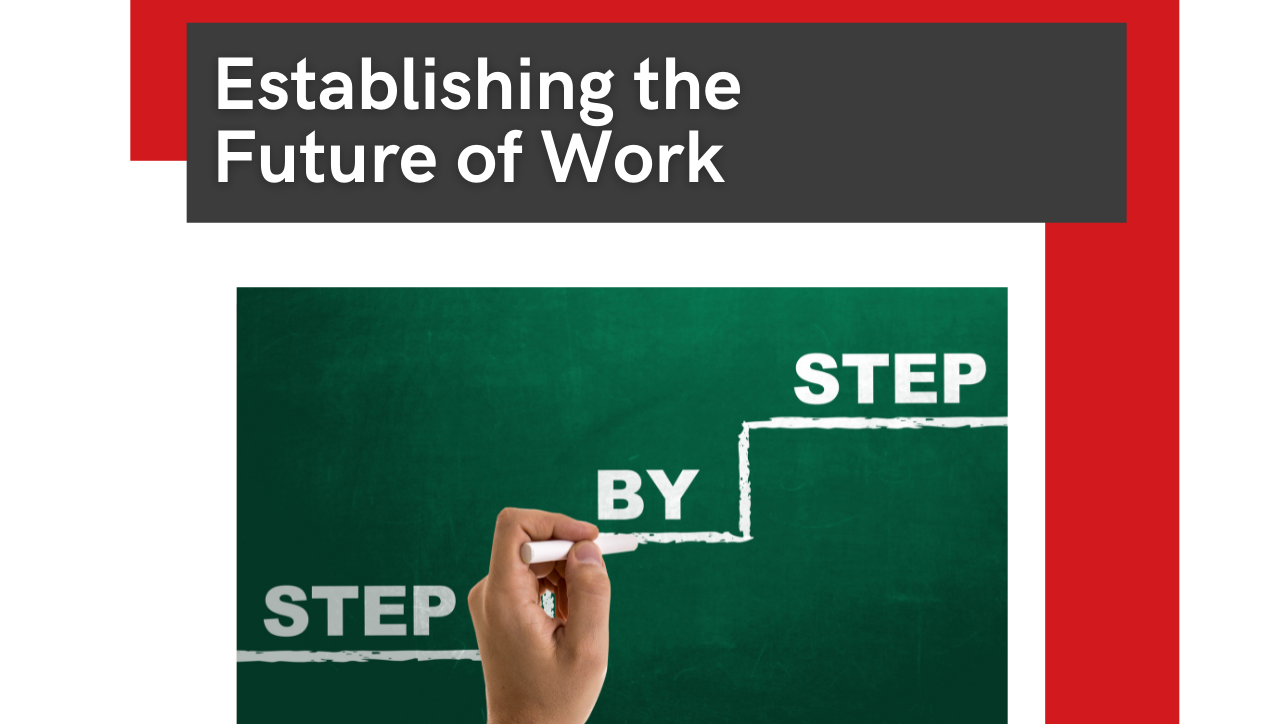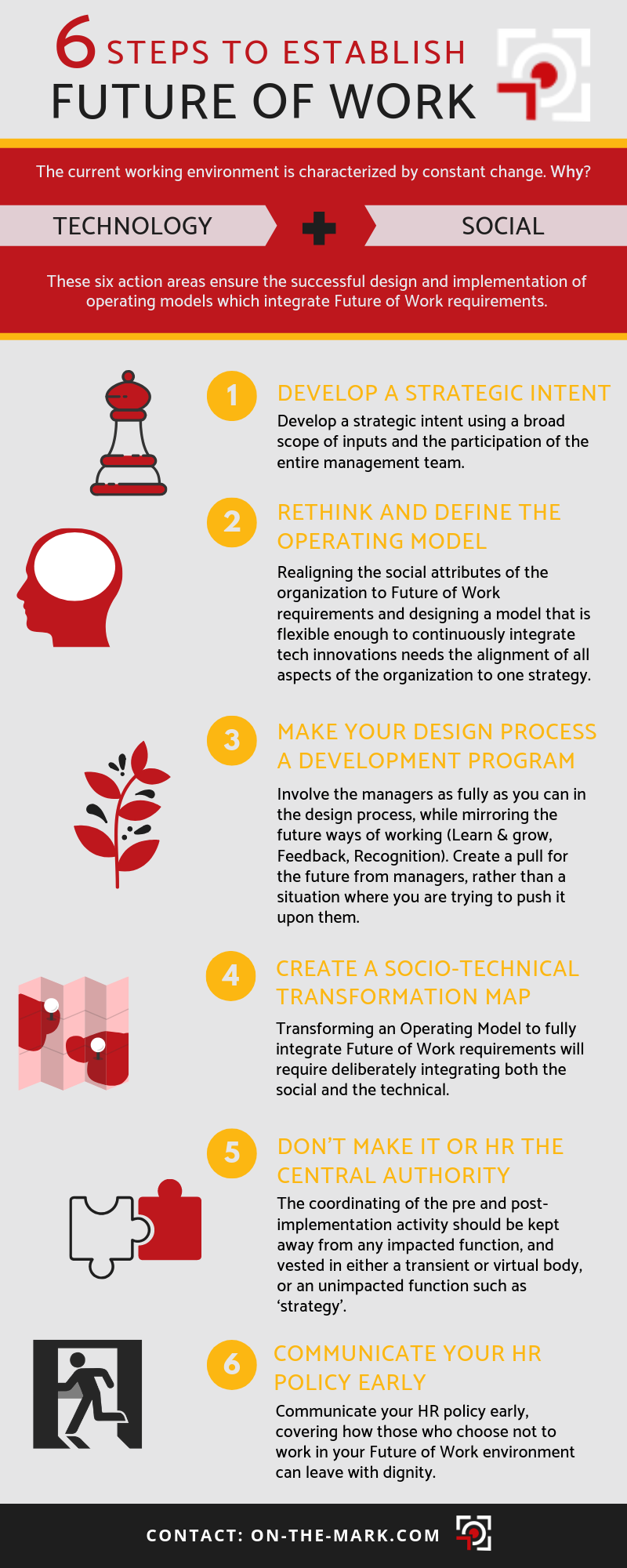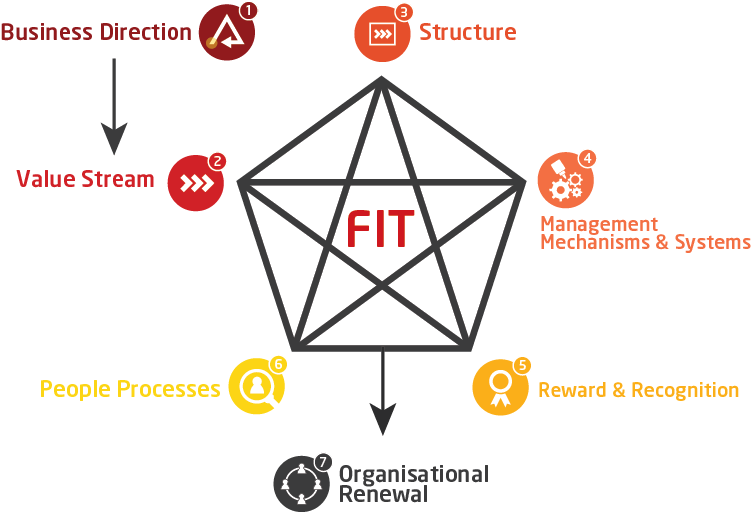Takeaway: The current working environment is characterized by constant change. OTM’s six action areas to ensure the successful design and implementation of operating models integrate Future of Work requirements. These steps can be followed either at the macro organization-wide level, or at a sub-boundary level such as a Business Unit or even a Function.
It’s been likened to the Industrial Revolution back in the late 18th and early 19th centuries when society adapted to the switch from a self-contained subsistence way of living to one dominated by trade, and the organized creation of products and services based on specialism, mass production in factories and economies of scale.
Looking back, we can see a certain amount of constancy in our working environment in the last fifty or so years. Of course, it never feels that way for the people living through such an era, but up until recently the prevailing mindset was for people to have a working life and a personal life that were often quite separate from each other. Of course, they overlapped, but in general, people were happy to keep them separate.
Working provided the resource that enabled a fulfilling personal and family life – people worked to live. People did what they could to feel happy and fulfilled within their working environment and enlightened employers designed ways of working and environments that were initially satisfying, and more recently engaging.
We are now a society in transformation with the phrase, The Future of Work, often used to allude to the growing alignment of people’s work and personal lives, in addition to hypothesizing on various technology and design scenarios. . The Future of Work is being shaped, in the main, by two forces:

This blog post is not an exhaustive analysis of the drivers of the Future of Work. Many before us have addressed this, and there will be many more to come. We accept that people’s perception and expectations of work are changing. We accept that technology can be a positive enabler of change. Upon these premises we try to establish the success factors which can enable organizations of all kinds to create a ‘pull’ from both within and outside the organization for new ways of working, rather than having to ‘push’ the Future of Work onto the workforce.
It is important to establish the drivers of the required transformation so that we can understand our start point and context. Drivers divide into the two categories of Technology and Social.
Drivers of Future of Work
Technology
Technology is a driver that we are all aware of, but we are not always clear about how it will affect the way that work is done in the (near). Information technology has evolved rapidly to permit global communication in ways that we could not even imagine 20 years ago.
We all know that we live in a world where virtual working on collaborative platforms is a given – a world where we can be ‘always connected through the internet of things’, a world in which where and when the work gets done is less important than how the work gets done. Technology has been used to digitize the more administrative and repetitive tasks, automation has been designed to take on physical tasks in a factory environment with robots able to work consistently and tirelessly 24/7 when required.
A direct consequence has been the blurring of lines between work and home life. Home workers report the difficulties of switching into work or switching off from work when in the same environment.
Looking backward, technology has changed the way both routine and physical work gets done. As we look forward, Artificial intelligence (AI) will quickly impact upon the way managerial work gets done. Algorithms that draw, in real time, on multiple data sets will make decisions and continuously learn from the decision made in order to make better decisions next time.
A direct consequence will be an erosion of the amount of ‘management work’ in the organization which will require a fundamental rethinking of the core operating model.
The mantra of the work that creates value for customers in the organization’s end-to-end value stream being done by ‘frontline employees’, and the role of management being to ‘glue’ the work together, set direction and make decisions will no longer hold true as more and more management work is digitized and completed by AI systems.
Through an organization designer’s lens, management mechanisms will continue to be essential in any operating model – AI does not change what needs to be done, it changes where and how it is done.
Social
People’s expectations of the world of work in the future is less easy to assess completely objectively. It is hard to be definitive about the future Social attributes of an organization. However, we must not forget that many of the future managers and leaders from Millennials and Gen Z are already working in the organization today. Much has been written about the Millennial generation, some judgmental, some praising, some based on facts, making it hard to distill the important factors to consider when designing work.
We know that today, 50% of the working American population are Millennials and that by 2025 this will be 75% globally—a demographic change that can’t be ignored. Many researcher and commentators have pointed out the attitudinal change of the Millennial generation in many developed countries, noting a strong desire to balance working lives ever more carefully with their personal lives.
In a world where manual skills are being replaced by cognitive skills, a world where the interpersonal and creative roles, with uniquely human skills like creativity, customer service, care for others and collaboration are increasing, it is probably no surprise what Millennials’ expectations are in work environments:

It is easy to argue that there is little new here. The challenge is to design a future-proof operating model, with roles and jobs that continue to meet these expectations as the how, when and where of the work changes to integrate emerging technology.
There are many consequences for organizations and employers, not least the requirement to be transparent about their values, and then continuously deliver to them no matter what. We witness the continual adjustment from businesses (and indeed other organizations) who now realize that nothing less than full transparency will do.
For people graduating from further education, it’s not all about the pursuit of a career; it’s about a more holistic management of their lives. There’s no longer an automatic assumption that a career is the backbone of one’s life. It is anticipated that many more roles will become external or contracted roles and whole swathes of junior and middle management could switch out of “standard” employment models. This is driven by employers looking to optimize technology and AI and reduce their fixed cost burden, and also workers looking for the benefits of flexibility through the gig-economy or through mixed portfolios of work.
This then requires all sorts of new “glue” mechanisms to create the social systems that build the appropriately supportive, efficient and effective working environments.
“Design for the culture you want, or you will get the culture you get”.
OTM’s 6 steps to establish your Future of Work
Now we have our context, let’s look at OTM’s six action areas to ensure the successful design and implementation of operating models which integrate Future of Work requirements. These steps can be followed either at the macro organization-wide level, or at a sub-boundary level such as a Business Unit or even a Function.
1. Develop a strategic intent using a broad scope of inputs and the participation of the entire management team
This is where it all starts – ‘Form follows function’.
Operating models and how work gets done over the next 5-10 years will be driven by the needs and expectations of the Millennial and Gen Z generations, and enabled by information technology, automation and AI. The strategic intent of the organization must encompass Future of Work requirements that cover both the desired future social attributes (culture if you must!) and the use of technology in its broadest sense as an enabler.
In many organizations, the management/leadership team have limited understanding of the needs of Millennials/Gen Z alongside a limited understanding of the possibilities of future technology and AI. Start any alignment of the operating model to the Future of Work by providing an opportunity for Millennials/Gen Zs to give input to the strategy, which will determine their working lives. Provide feedback to them on how you have used their input and recognize their contribution – model future behaviors.
2. Rethink and redefine the whole Operating Model – don’t tinker around the edges.
Realigning the social attributes of the organization to Future of Work requirements and designing an Operating Model that is flexible enough to continuously integrate technological innovations needs the alignment of all aspects of the organization to one strategy and to the work that adds the value for customers.
OTM’s Applied Star Model provides one framework to do this in a systematic and holistic way ensuring everything is aligned to the same objectives. Through the application of this framework, Future of Work attributes embedded in the strategy will naturally be included in resultant design criteria and flow through to a new Social systems once the new Operating Model is implemented and the organization has been renewed.
3. Make your design process your management and leadership development program.
A change impact analysis on any future Operating Model designed around Future of Work requirements will inevitably highlight that the stakeholders most impacted by the change are the current managers.
-png-1.png)
Remember that the position of the current managers is the most threatened by the Future of Work, so don’t underestimate the fact that if they don’t support the new design, then they are in an ideal position to sabotage it.
Involve the managers as fully as you can in the design process alongside Millennials and Gen Z employees, while mirroring the future ways of working (Learn & grow, Feedback, Recognition) – we refer to this as design compatibility. Create a pull for the future from managers, rather than a situation where you are trying to push it upon them. However, you must give them a dignified exit route (See Step 6) if they decide that your Future of Work is not for them.
4. Create a socio-technical transformation map
Transformation doesn’t happen by chance. Transforming an Operating Model to fully integrate Future of Work requirements will require deliberately planning both the Social and the Technical milestones to ensure that the Social System is ready before the Technical change is begun to be implemented. Ensure that there are measures in place to check that the Social System is ready before the Technical change is implemented, implementing a Technical change into a Social System that is not ready will inevitably lead to the planned news ways of working not being adopted and workarounds being developed to maintain the status quo.
5. Don’t make IT or HR the central authority for coordination of implementation activity
Transforming the Operating Model is an organisation-wide initiative that impacts and integrates all aspects of the enterprise, changing both the core value creating work, the enabling work (such as HR and IT) and the management work and mechanisms. For this reason, the coordinating of the pre and post-implementation activity should, ideally, be kept away from any impacted function and vested in either a transient or virtual body, or an unimpacted function such as ‘strategy’.
6. Early communication of your HR policy, covering how those who choose not to work in your Future of Work environment can leave with dignity.
Always be on the front foot when it comes to how people who leave the organization will be treated, have your HR policy in place and communicated very early in your redesign process. An Operating Model transformation, no matter how collaborative and inclusive, will inevitably result in the design of future ways of working, roles and jobs which do not suit everyone. Once the design of the future operating model is completed and signed-off compromises cannot be made to suit the desires of a small number of individuals, as a result some people will choose/need to leave the organization. In OTM’s extensive experience, when an organization undertakes a full Operating Model redesign between 20% – 40% of the leadership will leave. When this happens, everyone is watching (including not only those for whom change is positive, but also your customers) and the organization will put itself in the best possible light by visibly demonstrating respect for those leaving and allowing them to leave with dignity.
Conclusion
Integrate your Future of Work requirements into your strategic intent before you begin to redesign your Operating Model. Cover both the Social and the Technical aspects of the Future of Work and involve all stakeholders in both the strategy setting and the design and implementation processes. Social milestones drive Technical milestone, never vice versa.
Stay up to date on the organization design world and sign up for blog notifications so you never have to miss out.
OTM is the leading global boutique organization design consultancy with offices in the USA and UK. With over 450 successful redesigns and operating model modernizations completed, OTM is owner of the industry’s most integrated, comprehensive and holistic organization design solution. OTM enables its clients to realize their future ambitions.






